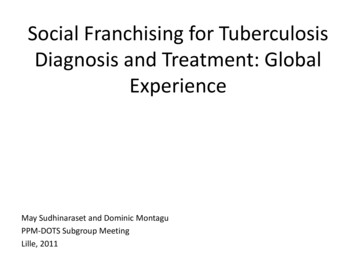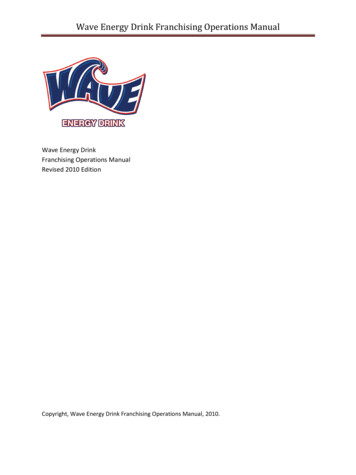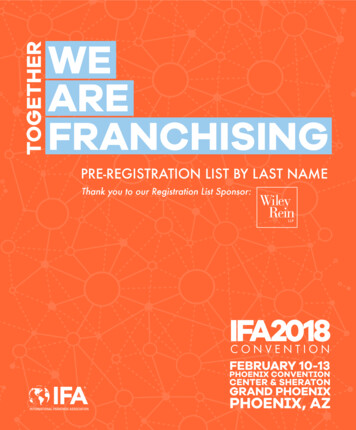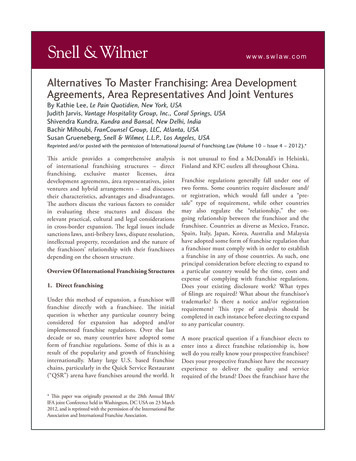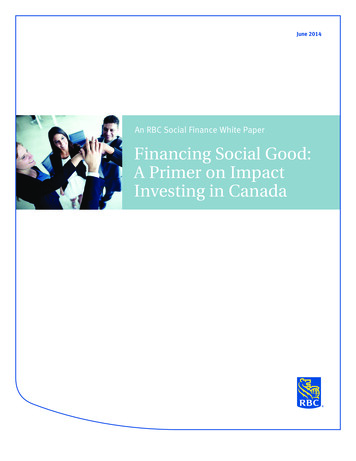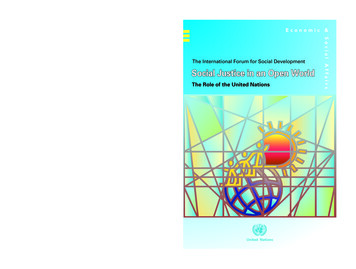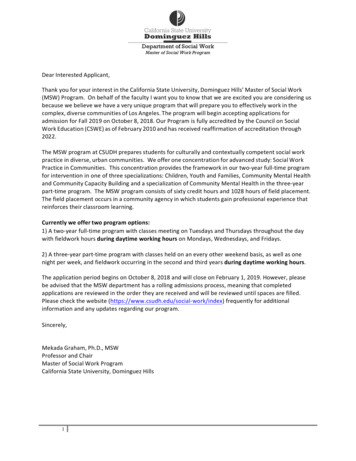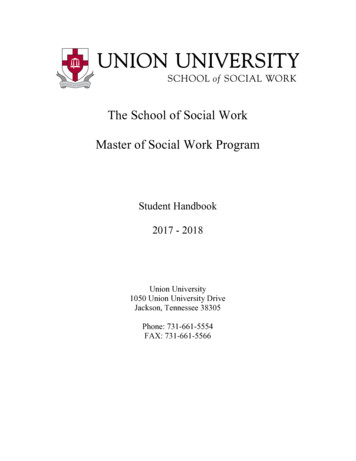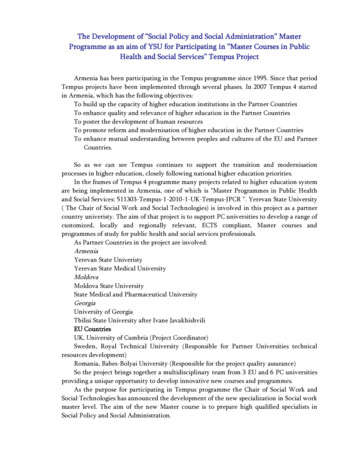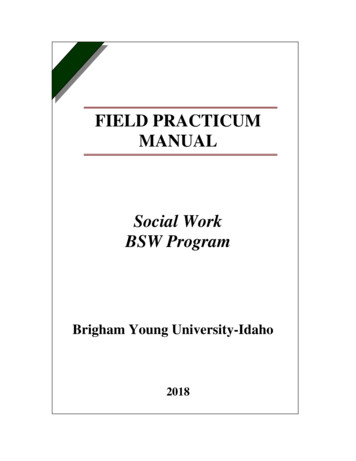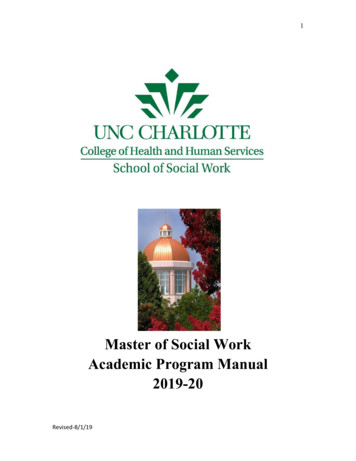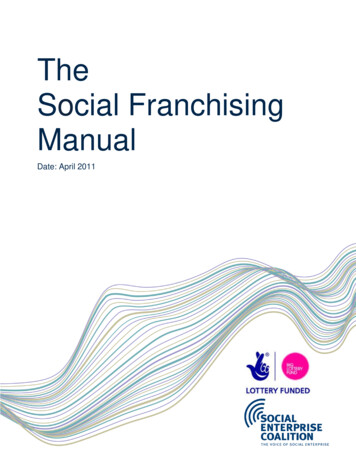
Transcription
TheSocial FranchisingManualDate: April 2011
Contents:10 Steps to Social Franchising .2What is Social Franchising?.3Social franchising: why and when? . 6What are the key elements of a (social) franchise? . 10Franchise agreements . 11What are the key differences between social and commercial franchising?What is the „social‟ element of a franchise? . 13Frequently Asked Questions . 16Support, training and advice 8. Further information . 20APPENDIX 1: CASE STUDIES APPENDIX . 22APPENDIX 2: Template franchise agreement . 29Acknowledgements:This manual was developed by Nick Temple, with editorial management by Craig Carey, HollyBrereton and Olof Jonsdottir.The Social Enterprise Coalition would like to thank the Big Lottery who funded this manual as part ofa wider project on growing the social enterprise movement through franchising and other forms ofreplication.We would also like to thank the organisations who generously contributed their stories andknowledge to this manual, including: Aspire, Fruit to Suit, Green-Works, Hidden Art, School forSocial Entrepreneurs, and Sunderland Home Care / CASAThe Social Enterprise Coalition is the UK's national body for social enterprise. The Social Enterprise Coalitionrepresents a wide range of social enterprises, regional and national support networks and other relatedorganisations. As well as showcasing the benefits of social enterprise, and sharing best practice we workclosely with our members to inform national policy.CAN Mezzanine, 49-51 East Road, London N1 6AHEmail: craig.carey@socialenterprise.org.ukWeb: www.socialenterprise.org.ukPublished 20111
This how-to guide provides a general introduction to social franchising, and practical advice on howto franchise a social enterprise. It is primarily aimed at those thinking of franchising theirorganisational model (potential franchisors) but will be of use and relevance to a broader audience.Franchising is not a simple process, but the 10 steps below give a simplified indication of how thisprocess works for most organisations.10 Steps of Social Franchising1. Consider different forms of replication: choose most applicable to your organisation2. Go through replication readiness exercise3. Raise funding or set aside money to invest in infrastructure / staff time4. Address / strengthen any weak or „unready‟ areas5. Prepare necessary documents (operations manual, franchise agreement, trademarks, feestructure)6. Select 1-2 pilot / test franchisees, using due diligence and criteria7. Provide initial training and (cultural) induction to franchisees8. Support (test) franchises in all aspects of operations in line with obligations, communicatingconstantly9. Assure quality of test franchises, and evaluate impact / success10. Learn, improve and repeat 6-9 with more franchises2
1. What is social franchising?In its simplest definition, social franchising is simply the application of commercial franchisingmethods and concepts to achieve socially beneficial ends. Or, to put it slightly differently:social franchising is the use of a commercial franchising approachto replicate and share proven organisational models for greater social impactA standard definition of social franchising has not been agreed to date, and the term hassometimes been used interchangeably with 'replication' or 'scaling'. This causes unnecessaryconfusion, as there are several different approaches to replication and scaling, of which socialfranchising is one.Growth and replication rolSocial franchising is part of a spectrum of replication strategies which range from the very flexibleand loosely controlled (dissemination, giving away for free, open source) to the more restrictive andtightly controlled (wholly-owned by central organisation). Social franchising sits between these twoextremes, but does demand a larger degree of involvement and control from the parentorganisation than partnerships or licensing.The initial definition above does require us to understand what we mean by commercial franchising.The most usual form of commercial franchising is business format franchising.Business format franchising is where the owner of a franchise system (the franchisor) enters into alegal agreement with another person or organisation (the franchisee) which grants that franchisee alicence to use its systems, brand and other intellectual property, and to use those to operate anidentical business in a particular area.The franchisor teaches the franchisee the entire business format, and provides support via trainingand communications to the franchisee for the duration of their business relationship. In return forthese systems and services, the franchisee pays an initial fee and ongoing fees to the franchisor.3
The same applies to social franchising, which should also include the following:- a legal agreement between franchisor and franchisee- ongoing obligations between franchisor and franchisee- the entire business format being duplicated, including the same brand- the franchisee being granted a particular territory to operate the business- fee payments from franchisee to franchisorThis list is also helpful in distinguishing franchising from licensing, which is a related but distinctapproach to replication.Licensing usually involves being granted a license to provide a service or sell a product, rather thanan entire business format or system. The relationship between a licensing organisation andlicensee is also looser than its franchising equivalent. This usually means a much smaller packageof training and support (and not ongoing), and often no ongoing fees payable after the initial licensepurchase. Moreover, licensees will usually not receive exclusive territorial rights, and the grantedrights are usually more limited.This is not to say that franchising is preferable to licensing; it may be that the lower upfrontdevelopment costs and lower ongoing costs (of fees) are preferable to the licensee. Similarly, thelicensing company‟s reduced level of involvement and support provision may be preferable formodels that require less control or for an organisation with less capacity.Other replication approaches include:Joint venture: A contractual agreement joining together two or more parties for the purpose ofexecuting a particular business undertaking, often for a finite period. The parties share control overthe enterprise, and agree to share in the revenues, costs and assets.Partnership: An agreement or arrangement in which two or more parties agree to work together formutual benefit or to advance their interests. Partnership can vary in complexity or involvement, andit is helpful to also think about a partnership continuum.4
Co-operation- information sharing- referrals- informal support- separate goals,structures, resourceslessCo-ordination- event / short-term project- some division of roles- some shared resources,risks, and rewards- individual identities keptcomplexity and intensityCollaboration- new structure / common goals- all parties contribute resourcesand share in rewards- longer-term commitment- durable partnershipsmoreJoint ventures are an example of a formal collaboration, and mergers would come even further tothe right of this continuum where complete integration is the aim, involving multiple variables andsignificant complexity.Open source / free dissemination: An approach to replication in which the methods, design, andcontent (all intellectual property) of a product or system are made freely and publicly accessible.The natural impulse of many in social enterprise is to simply share their learnings and methodsopenly, and disseminate them freely. In recent years, this has tended to be referred to as „opensource‟, after the open source software movement which shares openly its source code for anyoneto use and improve upon.5
2) Social franchising: why and when?Why social franchising?There are several reasons why a franchising approach to replication might be attractive to socialenterprises. For example, it:- grows social impact in line with mission, but without growing an organisation in a traditionallyhierarchical way that creates distance from the frontline- avoids reinvention of the wheel (and shares existing learning), making it quicker and easier tostart up- allows for local ownership, flexibility and tailoring to context and circumstance- achieves benefits of national organisation (joint purchasing / bidding, policy credibility,effective communications, economies of scale)- shares successful models in a way that combines social and financial goals (social impact,financial sustainability)- works through genuine partnerships and for mutual benefit, under a common identity- devolves power and encourages entrepreneurship----------------The most important of these reasons is arguably that social franchising combines the socialobjectives (sharing learning and methodologies for greater social impact) with the financialobjectives (charging fees for intellectual property and services for greater economic sustainability).This link with the core values and principles of social enterprise is the reason that many considersocial franchising, if approached and implemented correctly, to be a potential „sweet spot‟ for thegrowth of social enterprise.Social franchising‟s combination of social and financial motivations is in contrast to the extremes oftraditional wholly-owned growth, in which little is shared but the organisation ensures its ownsustainability, and open-source dissemination, in which everything is shared, but with no revenue orcurrency flows attached.If some of the above reasons why an enterprise might consider a social franchising approach seemcompelling and interesting, it is worth following up with a simple and relevant tool which is included6
below. The tick-box list below, developed by LKM Consulting1, gives a swift indication of whetheran enterprise and its model would benefit from an approach with more flexibility or more control.Affiliation-based replication trolFactors that favour flexibility overcontrolFactors that favour control overflexibilityStraightforward modelMultifaceted, complex modelConcept-based businessBrand and mission requires protectionLow risk businessHigh risk business where mistakes couldhave significant consequencesSmall, informal and low cost operationsEstablished, proven business model withstrong structures & policiesDependent on circumstances, and adaptablebusiness structurePackage with considerable client recognitionand trustSelf-funding, earned income operationsEvidence of impact across operationsrequired for funders/investorsIndependent, contextualised organisations:lessons not always transferable & learnableNeed for regular sharing of information andtransferability of good practiceFew potential economies of scaleSignificant economies of scale to beexploited1 The report in which the original version of this table appears was produced for ATA Management by Loic Menzies ofLKM Consulting (see www.lkmconsulting.co.uk)2Some refer to this group of replication strategies as „affiliation-based replication strategies‟ as they involve working withan affiliate or partner to achieve replication.7
This exercise also identifies risk as an important factor. If a social enterprise works with youngpeople, at-risk groups, individuals with mental health problems or other disadvantaged parts ofsociety, it may well be that mistakes would have major, damaging consequences. This can makethe higher levels of control (and associated performance management and quality assurance)available in franchising attractive.When to franchise?This simple readiness tool is designed to provide a starting point for assessing whether a socialenterprise model is ready for franchising (of affiliation-based replication). It looks at whether themodel of delivery, the central systems and processes, and the franchising organisation itself areready.For each of the 10 areas, score the enterprise / organisation on a scale of 1-10,where 1 is “not at all ready” and 10 is “completely ready”.Commitment: buy-in from staff team and board Learnable: transferable knowledge and methods Operations: systems and procedures in place Need / demand: from end-users, franchisees, policymakersEvaluated: proven social impact Duplicable: able to be replicated locally Finances: sustainable and stable Identity: brand reputation and recognition Rewards: socially and economically valuable for both partiesModel: clearly understood and codifiedTOTAL:Scoring75-100:50-75:25-50:0-25:ready or almost ready to replicatestrengthening needed before replication undertakensome replication potential but too early currentlynot at all ready to replicate8
This is not in any way an exact science, and is intended primarily to highlight areas of weaknesswhich need to be addressed or strengthened. A useful
5. Prepare necessary documents (operations manual, franchise agreement, trademarks, fee structure) 6. Select 1-2 pilot / test franchisees, using due diligence and criteria 7. Provide initial training and (cultural) induction to franchisees 8. Support (test) franchises in all aspects of operations in line with obligations, communicating .
